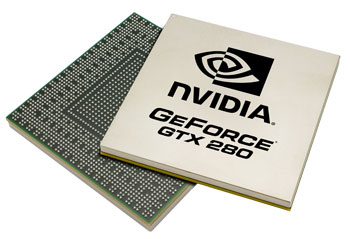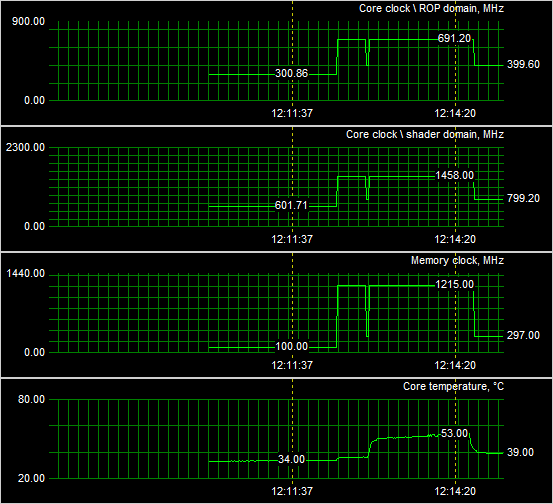4 - Installation | GPU temps | Power consumption | Noise levels
Power Consumption
 For a product of this caliber it's really not that bad. More transistors means more power consumption ... well you figured that out yourself already I guess. The new GPU however is one of the most energy aware products you'll find on the market today. NVIDIA made sure several new power states are active in the GPU. What this means is that depending on the task at hand you assign to the GPU, it'll react to that in terms of power consumption. NVIDIA's integrated these 'p-states' and allows the GPU to alter clocks, voltages and frequencies on the fly. Very interesting is that certain parts of the GPU when not used, can be shut down, preserving energy. In GPU terminology this is called clock-gating circuitry, it effectively "shuts down" blocks of the GPU which are not being used at a particular time, reducing power during periods of non-peak GPU utilization.
For a product of this caliber it's really not that bad. More transistors means more power consumption ... well you figured that out yourself already I guess. The new GPU however is one of the most energy aware products you'll find on the market today. NVIDIA made sure several new power states are active in the GPU. What this means is that depending on the task at hand you assign to the GPU, it'll react to that in terms of power consumption. NVIDIA's integrated these 'p-states' and allows the GPU to alter clocks, voltages and frequencies on the fly. Very interesting is that certain parts of the GPU when not used, can be shut down, preserving energy. In GPU terminology this is called clock-gating circuitry, it effectively "shuts down" blocks of the GPU which are not being used at a particular time, reducing power during periods of non-peak GPU utilization.
In the screenshot at the bottom of this page you can for example see the core domain hop from 300 towards 691 MHz when needed. But more interestingly, have a look at the shader domain, it's clocked down towards 600 MHz if not used. Once we fire of a 3D application at it it'll jump up towards it's designated clocks, and the same thing happens for the memory.
In idle this 1.4 Billion transistor encounting graphics processor consumes 25 watts. Another nice example is that movie playback is accelerated and enhanced over the GPU (Purevideo), when you decode 1080P content (Blu-ray) movies you'd figure that it would use up a lot of power, right ? Think again. Remember what I said about the GPU being able to shutdown segments of the GPU? Likely (and I'm not 100% sure here) mainly the video processor, IO and perhaps one shader block for some post-processing are at work. While decoding a 1080P movie over the GPU this product utilizes only 35 Watts. That's pretty amazing to be honest. Let's take an overview on what we just said:
- Idle/2D power mode: approx. 25W
- Blu-ray DVD playback mode: approx. 35W
- Full 3D performance mode: varies - worst case TDP 236W for GTX 280
- Full 3D performance mode: varies - worst case TDP 182W for GTX 260
- HybridPower mode: effectively 0W
Using a HybridPower-capable nForce motherboard a GeForce GTX 200 GPU can be fully powered off when not performing intensive graphics operations and graphics output can be handled by the motherboard's IGP.
So though the processor can peak towards 225-235 Watt with hefty gaming, the reality is that it's just as much as a GeForce 8800 Ultra, yet you have double the performance and the overall picture of this GPU in more common situations seems to be very energy efficient.
Setting up the PC
In general installing the card into your system will be a pretty easy job. Just slide the card into a free PCIe slot, connect one 6-pin and the 8-pin connector to the card. This water-cooled version obviously requires some other actions, which we'll show you in our photo-shoot. I do recommend you to buy a decent stable PSU with some reserves, as always. The PSU is an extremely important component in your PC.
Once the card is installed we startup windows. We install our driver, reboot and that was it. The card will work straight out of the box.
Testing Power consumption
We'll now show you some tests we have done on overall power consumption of the PC. Looking at it from a performance versus wattage point of view, the power consumption is not as bad as I expected it to be. The card according to NVIDIA has a TDP of roughly 237 Watts.
The methodology is simple: We have a device constantly monitoring the power draw from the PC. After we have run all our tests and benchmarks we look at the recorded maximum peak; and that's the bulls-eye you need to observe as the power peak is extremely important. Bare in mind that you are not looking at the power consumption of the graphics card, but the consumption of the entire PC.
Our test system contains a Core 2 Duo 3.0 GHz / FSB 1333 Processor, the nForce 680i mainboard, a passive water-cooling solution on the CPU, DVD-rom and a WD Raptor drive. The results:
- PC in Idle = 169 Watt
- PC 100% usage (wattage gaming Peak) = 393 Watt
The monitoring device is reporting a maximum system wattage peak at roughly 393 Watts, and for a PC with this high-end card. Idle wattage however could have been lower, yet we believe this was a driver issue. We'll check this in future reviews of board-partner products once a new driver arrives.
* Update - with a retail sample it worked fine. IDLE wattage dropped to roughly 155 Watt, really good.
Recommended Power Supply
So here's my power supply recommendation:
GeForce GTX 260 | 280
- A GeForce GTX 260 requires you to have a 500 Watt power supply unit at minimum if you use it in a high-end system. That power supply needs to have (in total accumulated) at least 38 Amps available on the 12 volts rails.
- A GeForce GTX 280 requires you to have a 550 Watt power supply unit at minimum if you use it in a high-end system. That power supply needs to have (in total accumulated) at least 40 Amps available on the 12 volts rails.
GeForce GTX 260 | 280 SLI
- A second GeForce GTX 260 requires you to have a 700 Watt power supply unit at minimum if you use it in a high-end system. That power supply needs to have (in total accumulated) at least 50 Amps available on the 12 volts rails.
- A second GeForce GTX 280 requires you to have a 800 Watt power supply unit at minimum if you use it in a high-end system. That power supply needs to have (in total accumulated) at least 55 Amps available on the 12 volts rails.
- 3-way SLI ... well check our article on Wednesday please.
There are many good PSU's out there, please do have a look at our many PSU reviews as we have loads of recommended PSU's for you to check out in there. What would happen if your PSU can't cope with the load?:
- bad 3D performance
- crashing games
- spontaneous reset or imminent shutdown of the PC
- freezes during gameplay
- PSU overload can cause it to break down
Noise Levels coming from the graphics card
When graphics cards produce a lot of heat, usually that heat needs to be transported away from the hot core as fast as possible. Often you'll see massive active fan solutions that can indeed get rid of the heat, yet all the fans these days make the PC a noisy son of a gun. I'm doing a little try out today with noise monitoring, so basically the test we do is extremely subjective. We bought a certified dBA meter and will start measuring how many dBA originate from the PC. Why is this subjective you ask? Well, there is always noise in the background, from the streets, from the HD, PSU fan etc etc, so this is by a mile or two not a precise measurement. You could only achieve objective measurement in a sound test chamber.
The human hearing system has different sensitivities at different frequencies. This means that the perception of noise is not at all equal at every frequency. Noise with significant measured levels (in dB) at high or low frequencies will not be as annoying as it would be when its energy is concentrated in the middle frequencies. In other words, the measured noise levels in dB will not reflect the actual human perception of the loudness of the noise. That's why we measure the dBA level. A specific circuit is added to the sound level meter to correct its reading in regard to this concept. This reading is the noise level in dBA. The letter A is added to indicate the correction that was made in the measurement. Frequencies below 1kHz and above 6kHz are attenuated, where as frequencies between 1kHz and 6kHz are amplified by the A weighting.
| TYPICAL SOUND LEVELS | ||
| Jet takeoff (200 feet) | 120 dBA | |
| Construction Site | 110 dBA | Intolerable |
| Shout (5 feet) | 100 dBA | |
| Heavy truck (50 feet) | 90 dBA | Very noisy |
| Urban street | 80 dBA | |
| Automobile interior | 70 dBA | Noisy |
| Normal conversation (3 feet) | 60 dBA | |
| Office, classroom | 50 dBA | Moderate |
| Living room | 40 dBA | |
| Bedroom at night | 30 dBA | Quiet |
| Broadcast studio | 20 dBA | |
| Rustling leaves | 10 dBA | Barely audible |
We test all cards on dBA levels. Obviously the reference coolers all perform roughly the same. The customized coolers are either louder or softer depending on what they try to achieve. Now I want to say 0 DBA here as the card does not make any sound as it has no active parts, however your water-cooling solution will have a radiator with one, two maybe three fans. That's the noise level, and it can vary from 35-50 DBA depending on how much cash you drop into a water-cooling rig.
We use a Black Ice dual radiator with two 120mm fans at 1200 RPM, and end up at 40 DBa.
The core temperature
Let's have a look at the temperatures this huge cooler offers.
So pretty much we fire off a hefty shader application at the GPU and start monitoring temperature behavior as it would mid-gaming, we literally stress the GPU 100% here. We measured at a set 21 Degrees C room-temperature.
Now a couple of things are interesting here. First of you an see the P-states we discussed earlier. In 2D mode the GPU tries to save power by lowering clocks & voltages, therefore running at a 400 MHz core frequency. The minute we fire off our shader application at the GPU the 3D mode activates and sets the default clocks to what they should be.

In idle you can expect, and don't cry of joy now a temperature of 34-35 Degrees C. Pretty chill. Yet once we push the GPU to 100%, the temperatures take a pretty hefty toll and settle at 53 Degrees C. And that's just 30-40 Degrees C less than the reference cooler. Brilliant.
Obviously again this is subjective as it is dependant on your water-cooling solution. That that is a killer CPU block that is slapped on top of the GTX 280 for sure.
